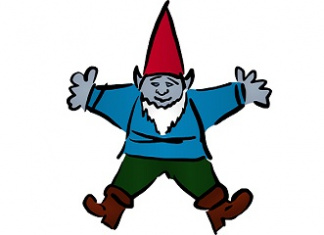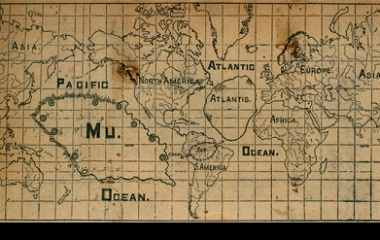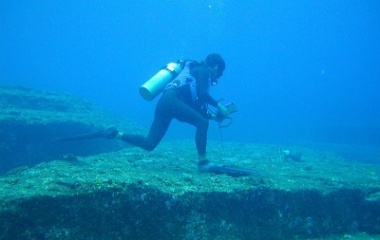Explorers and theosophists alike require an open mind to postulate and experience the unexplored, the dangerous and sometimes, according to their critics, the impossible. A mysterious lost continent, home to an ancient, advanced civilization that allegedly predated the Egyptian civilization, lived with dinosaurs and communicated telepathically – the vivid imaginings of such a liberal thinker or perhaps rooted in reality?
What is Mu?
Mu was an ancient lost continent which existed 12 000 years ago, according to 19th century writer and explorer Augustus Le Plongeon (1825 – 1908). In certain sources the island is also referred to as Lemuria, but cited as two separate lost worlds in other sources. The mythical concept was resurrected again in the 1930’s through the writing of James Churchward.
Where was Mu situated?
According to Le Plongeon, Mu was located in the Atlantic Ocean. His successor, however believed the continent was positioned in the Pacific Ocean, between Easter Island and Marianas from west to east and Mangaia and Hawaii on a south-north plane.
Le Plongeon on Mu
Le Plongeon first introduced the idea of Mu in his works after his extensive exploration of the Mayan ruins in the Yucatan region. He claimed to have translated ancient Mayan writings at the site, but unfortunately his translations were based on a misinterpreted version of the Troano Codex, an ancient pre-Columbian Mayan Book. The original translator, Charles Étienne Brasseur de Bourbourg, attempted to decode the glyphs contained in the book, but achieved only limited success with the endeavor. De Bourbourg had allegedly translated a word in the codex as Mu, a reference to a land which was submerged by a natural disaster.
Perhaps de Bourbourg’s interest in spiritualism or his speculations about the Maya and their connection to Atlantis were sufficient to hook Le Plongeon into the mystery of Mu. His wife, a spiritualist and regular séance attendee, may also have augmented his curiosity in the subject. Le Plongeon went on to interpret the writings as an indication that the Mayan civilization was older than the Egyptian or Greek civilizations. He further inferred that when the continent sank, a survivor of the disaster, Queen Moo, founded the Egyptian civilization whilst others fled to Central America and became the Mayan people.
Churchward on Mu
James Churchward, an author, engineer and inventor (1851-1936) was the next devotee beguiled by the enigma of Mu. He too had an interest in spiritualism and the occult, even believing he had a preternatural ability to read symbols from ancient cultures. He continued the notion of the lost continent in his writings on the subject from 1926 to 1933 including his work The Lost Continent of Mu, postulating its location in the Pacific Ocean. Churchward’s fascination with the subject was engendered by a chance meeting with a high-ranking temple priest in India where he was stationed as a soldier. The priest showed him clay tablets which allegedly came from Mu. The writing on the tablets were considered to be in the “Naga-Maya” language, the language of an ancient people from Tibet.
With the knowledge bestowed on him by the religious elder, Churchward went on to describe the people of Mu as an advanced civilization called the Naacal who existed between 50 000 and 12 000 years ago. At the height of their civilization they were said to have 64 million inhabitants living in large cities. His interpretations of the Indian tablets suggested that Mu was formed when underground volcanic gasses expanded and pushed the landmass above sea-level. Churchward claimed the continent was finally destroyed in only one night by a series of earthquakes and volcanic eruptions.
With his studies of the subject, he entertained the belief that all megalithic artworks worldwide originated from Mu. He noted the commonalities in the symbols on the giant stone remains, like images of the sun, birds, and the relationship between the sky and Earth. He claimed that the King of Mu was also called Ra and linked the name to the Egyptian god Ra. These connections may have resulted from his view that a rectangle translated as an M in the Muvian alphabet, thereby attributing any rectangle, used even decoratively, to Mu.
Propagation of the Myth
After Churchward, further claims of the existence of Mu were pursued by Theosophist William Scott-Elliot (1849-1919) and author James Bramwell, in his works Lost Atlantis published in 1937. Bramwell alleged that the last major cataclysmic event occurred on Mu in 9564 BC.
In the early 20th century the founder of the Turkish republic, Atatürk, thought Mu may have been the origin of the original Turk homeland. In the latter half of the century, Masaaki Kimura, Professor Emeritus of the University of Ryukyus Faculty of Science, claimed underwater structures off the coast of Yonaguni Island, Japan, may be ruins of Mu.
The Myth Debunked
The existence of Mu has however, been completely discounted by modern-day science through the geographical knowledge on plate tectonics. As the Earth’s crust is made up of sial rocks forming the continental crust which float on heavier sima rocks forming the oceanic crust, it is not possible for a continent to sink into the ocean, at least not within the space of a day or even a few hundred years. It is possible for the shape and position of continents to be changed by continental drift, but scientists say the phenomena takes hundreds of millions of years. Additionally, scientists have found no trace of major cataclysmic events on the ocean floor to prove the existence of Mu.
Archeologists have established that the Americas and the Old World (Africa, Europe and Asia) definitely developed separately and adhere to the belief that society evolved rather than devolved from the occultist notion of ancient superior beings and civilizations.
Further errors in Le Plongeon and Churchward’s theories come to the fore with the misinterpretation of the Troano Codex. With recent deciphering, its text appears to provide information on astrology!
Mu on a Metaphysical Level
The mysteries of the lost continent were even associated with metaphysics by Russian spirit-medium, occultist, and theosophist Helena Blavatsky (1831-1891). She co-founded the Theosophical Society in New York in 1875 and introduced the concept of root races. Root races were, according to Blavatsky, stages in human evolution. The first root race was cited as Polarian; an ethereal race. The second root race lived in Hyperborea and were a golden yellow color. This introduces the connection to Le Plongeon’s lost continent, as the third root race lived on Lumeria and were black. The theosophists believed the Lumerians co-existed with the dinosaurs, were much taller than current Homo sapiens and, Blavatsky claimed, had a third eye which they used to communicate telepathically! The fourth race were purported to have inhabited Atlantis.
Was the lost continent of Mu based in fact or in the creative extrapolations of a liberal mind? The mystery of the sunken island and its advanced society certainly proved too enticing for the explorers, occultists and theosophists who took up the mantle. Driven by the unknown, danger and their much needed self-assurance, which may have bordered on narcissism, the mysterious lost continent continued its grip on its acolytes for over a century. Yet, without the postulation of apparently extraordinary phenomena, no new discoveries would ever be made and so we validate these past efforts and venerate those to come, whether believable or not!










I was wondering where I can buy various maps of Mu, Lemuria and Atlantis?